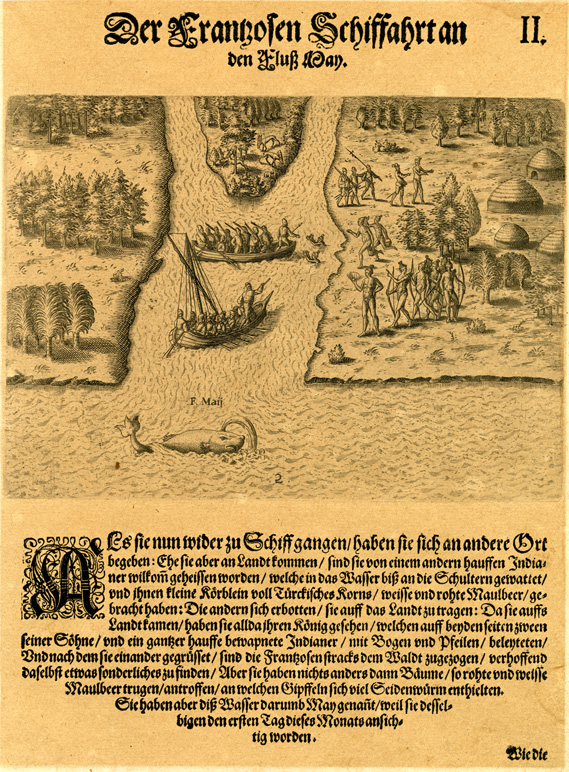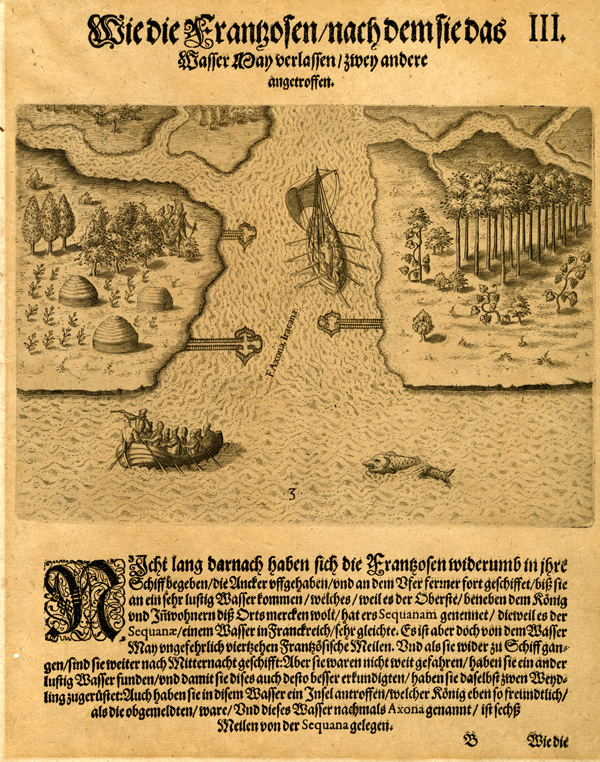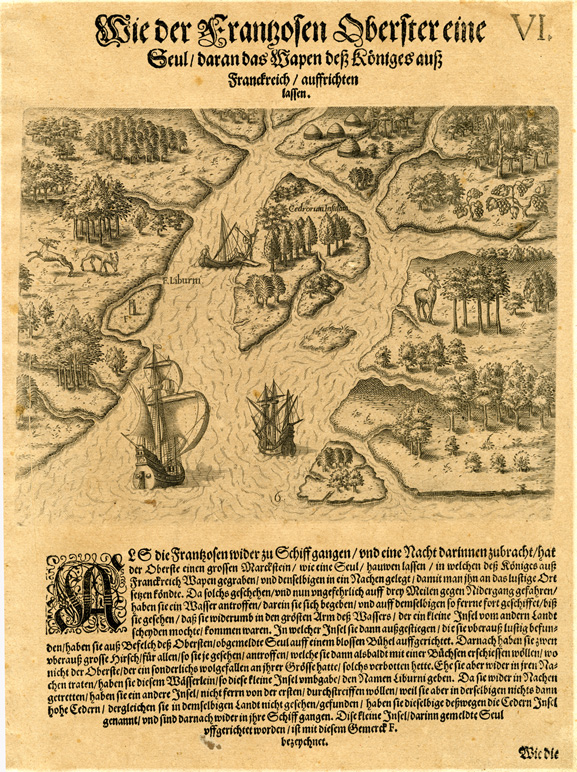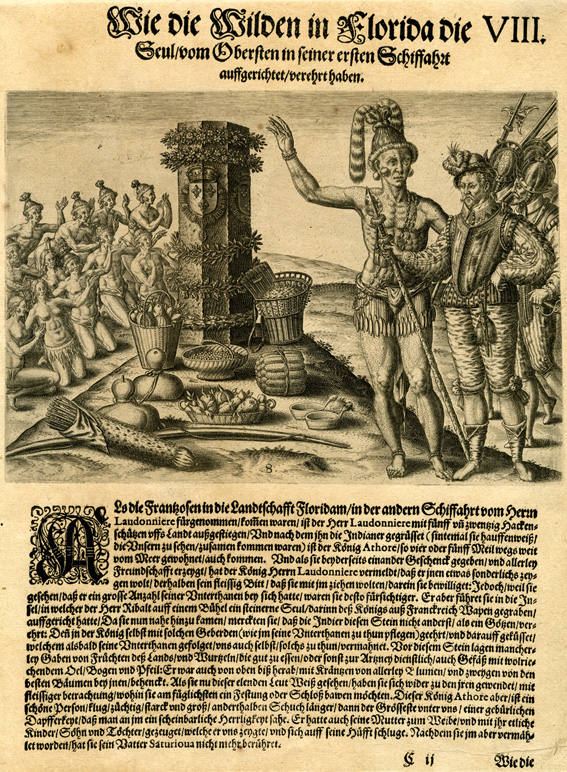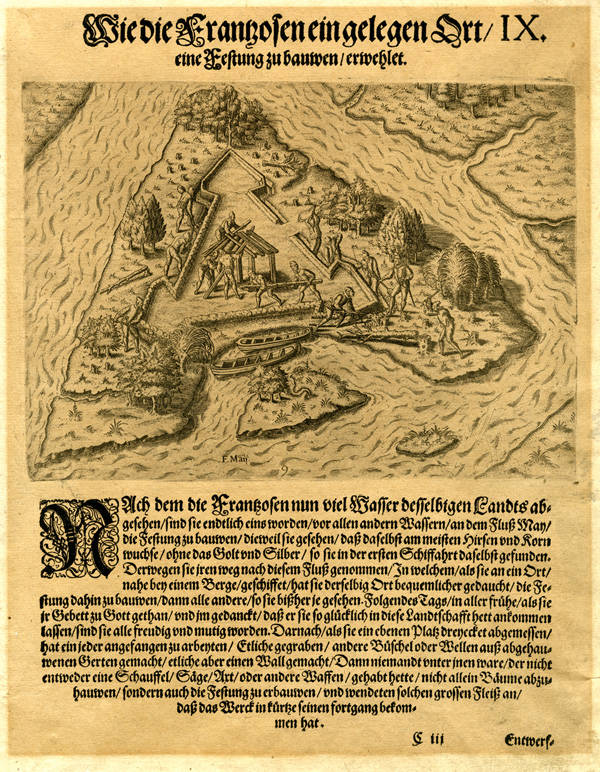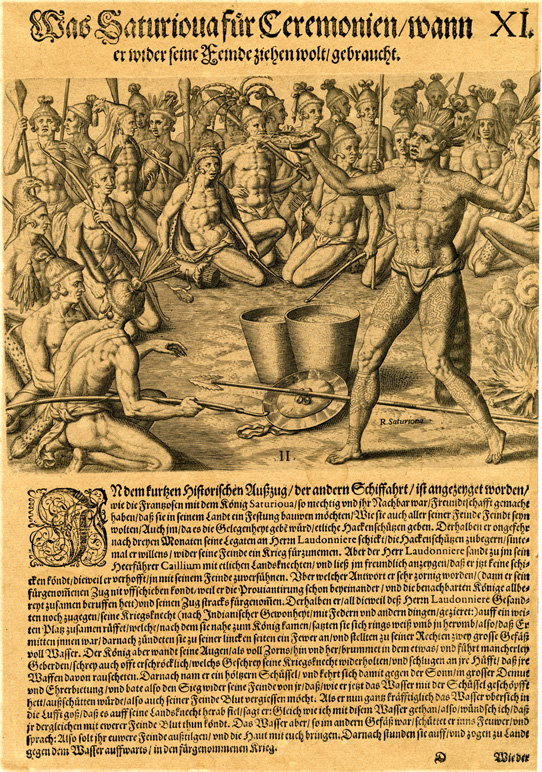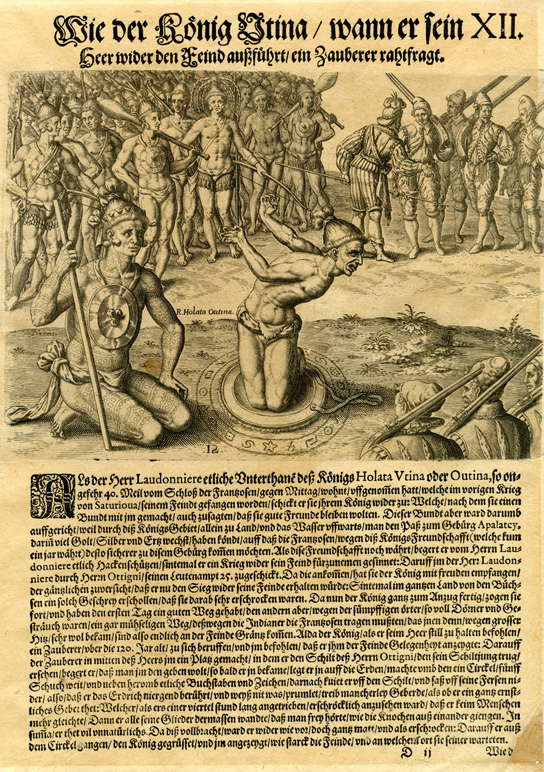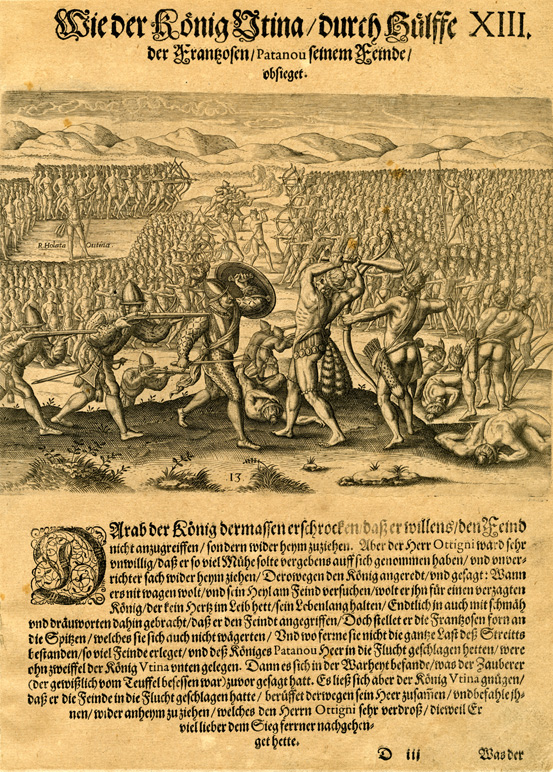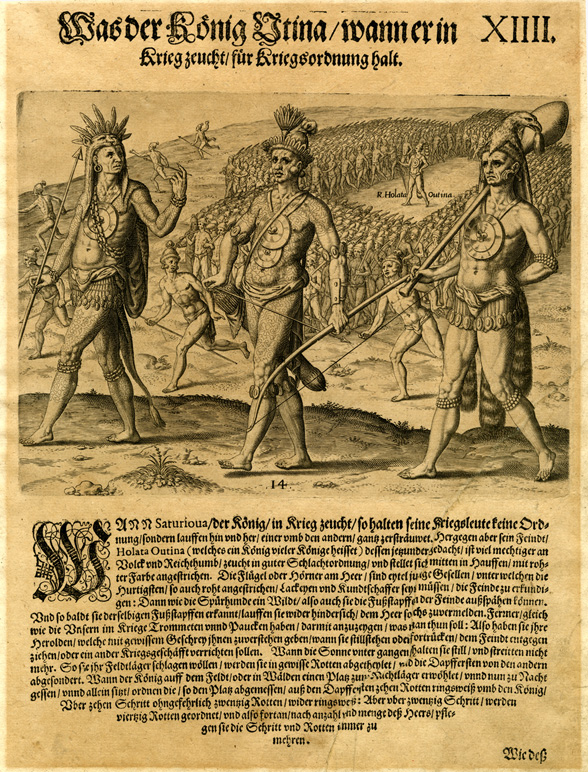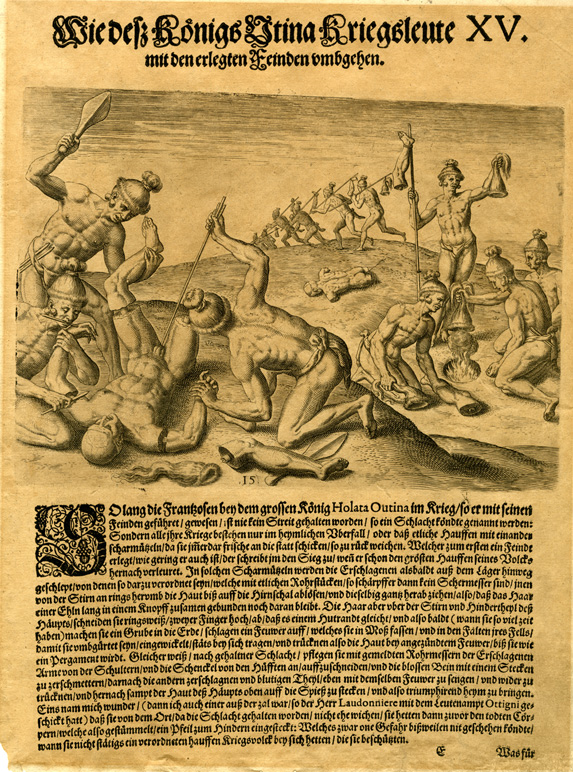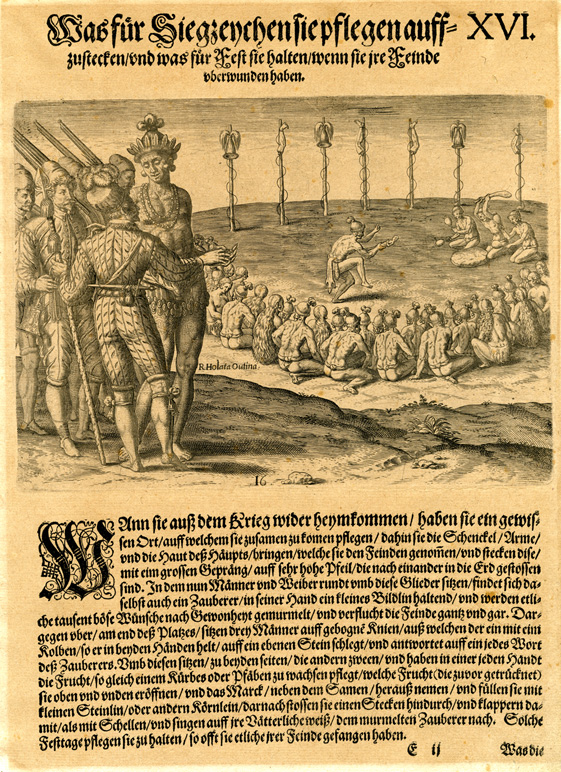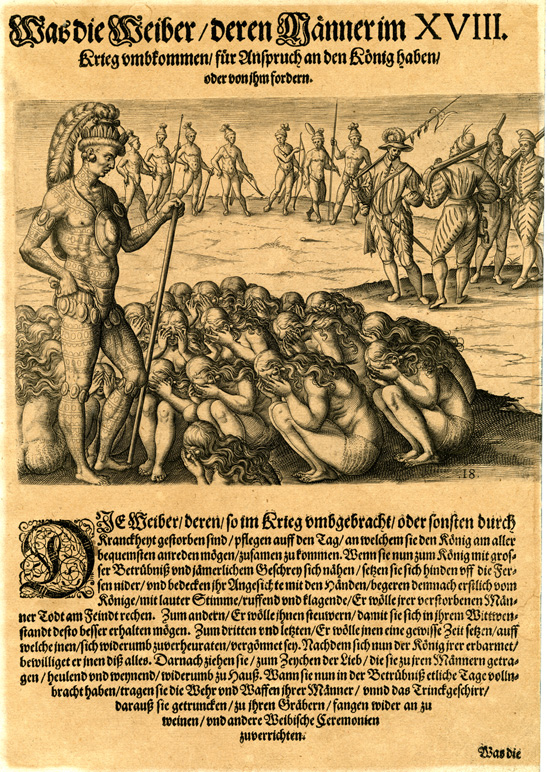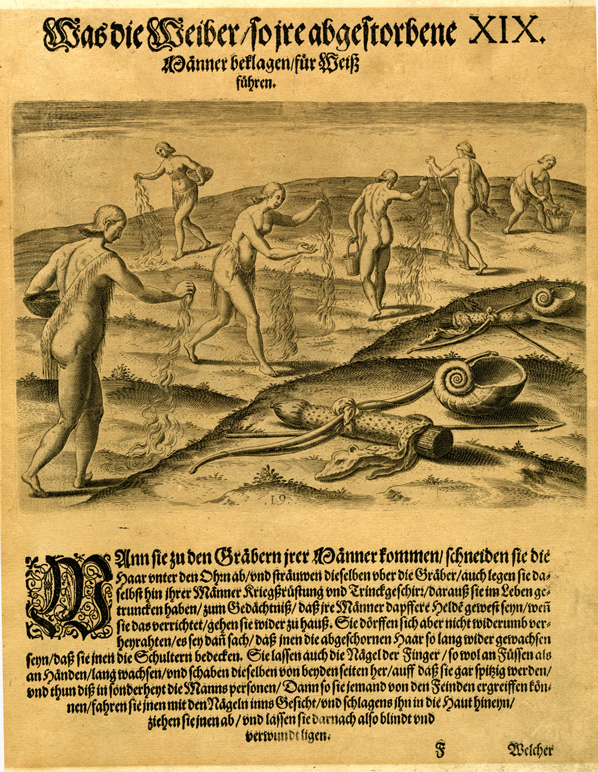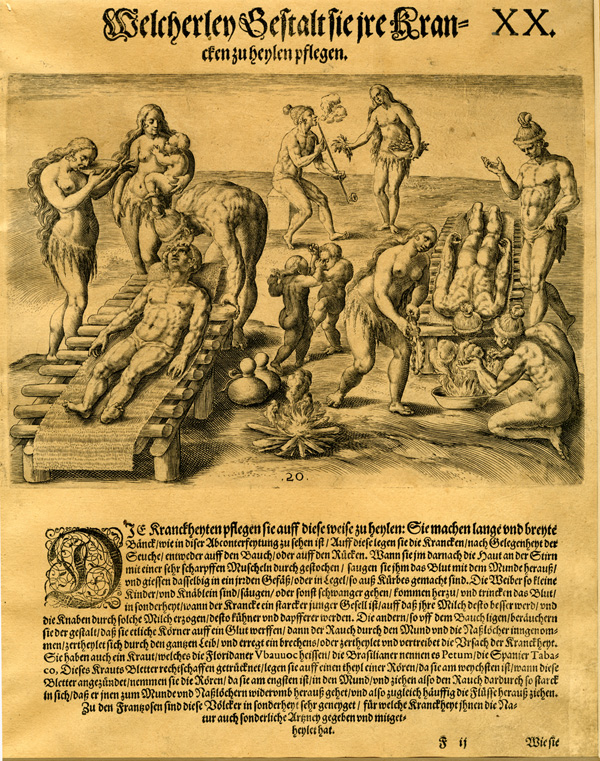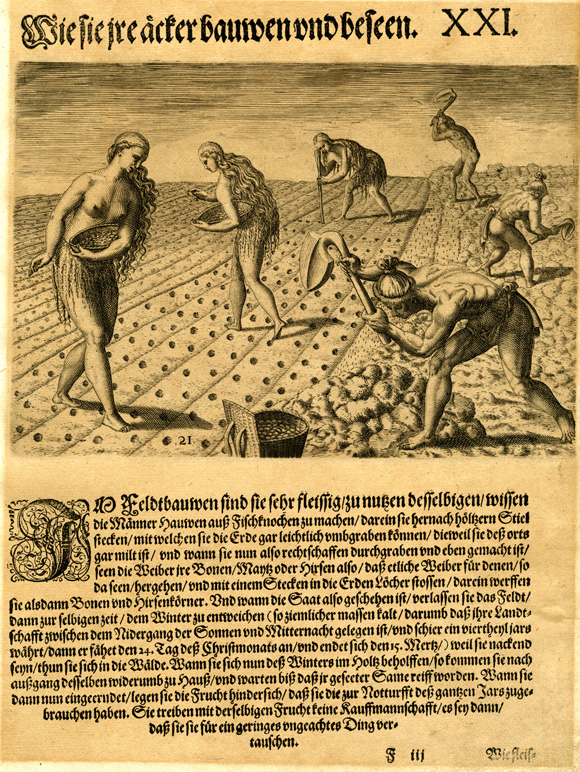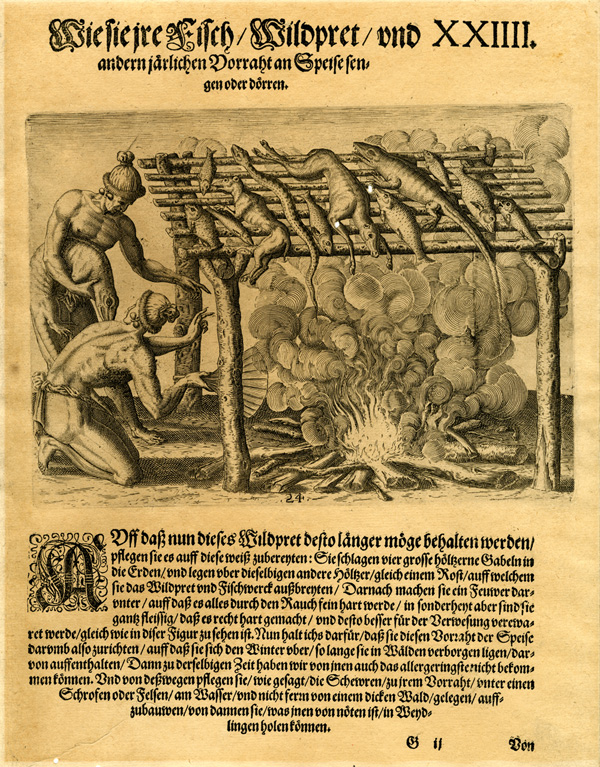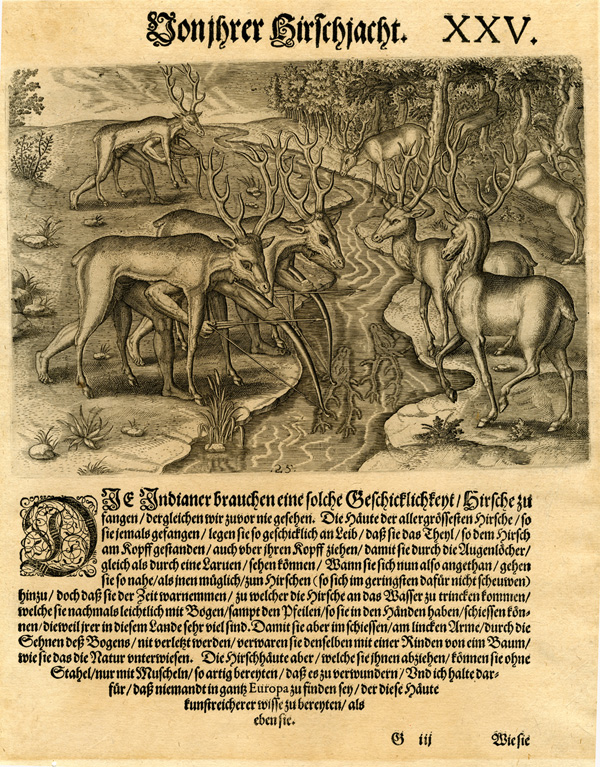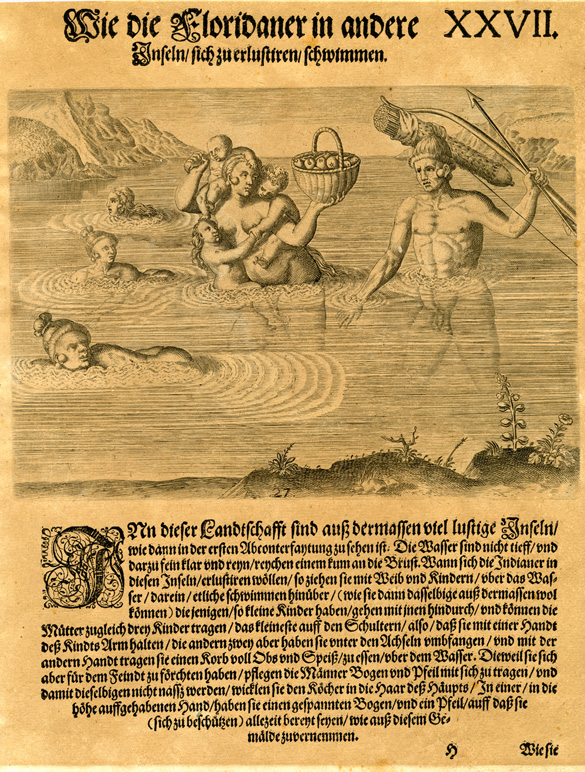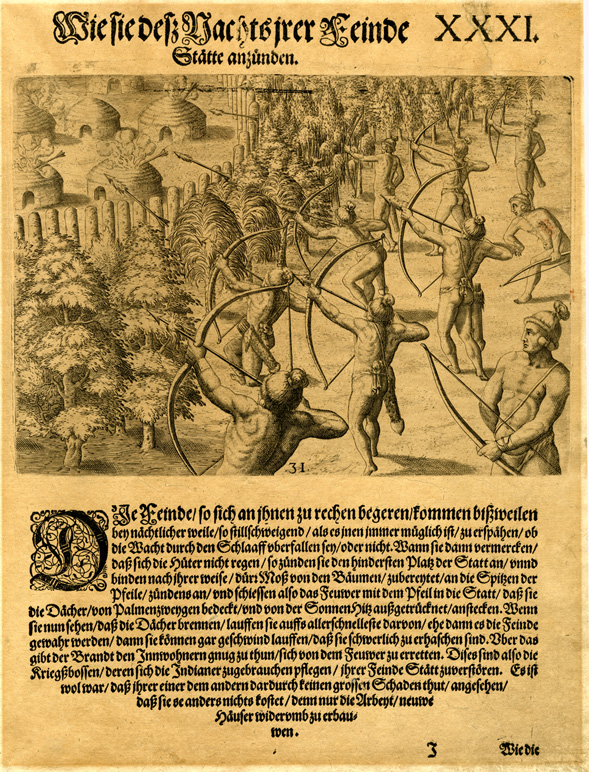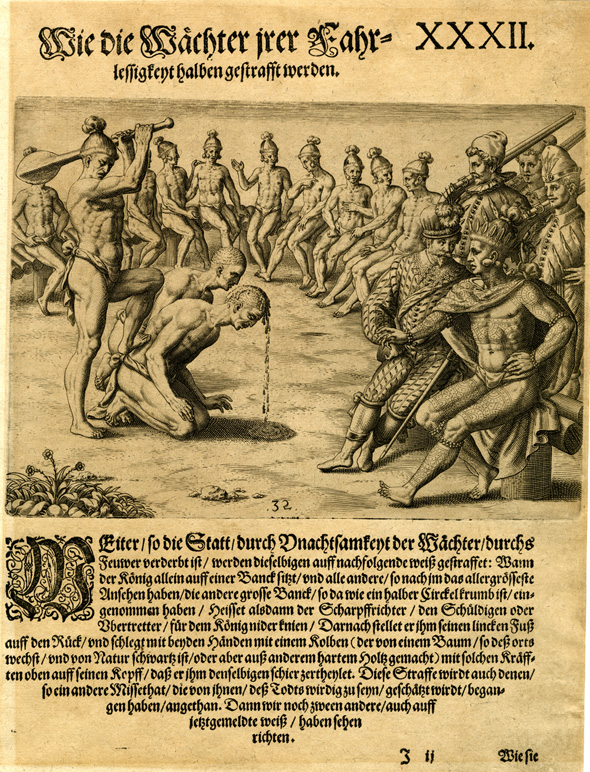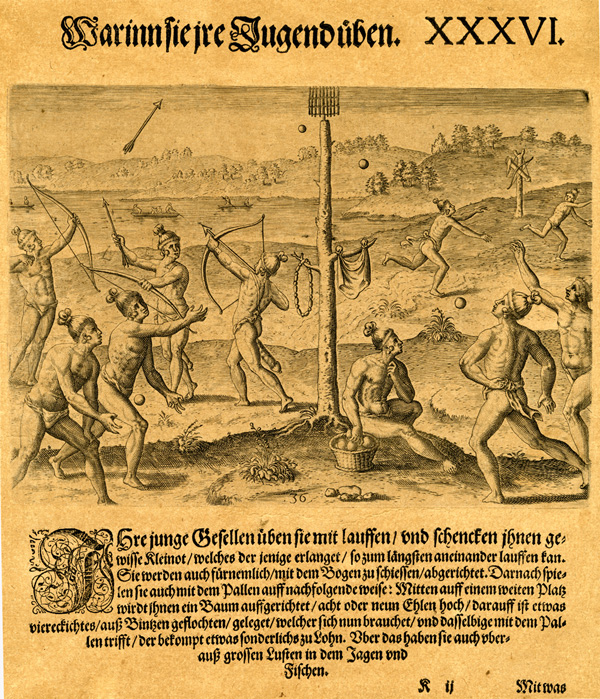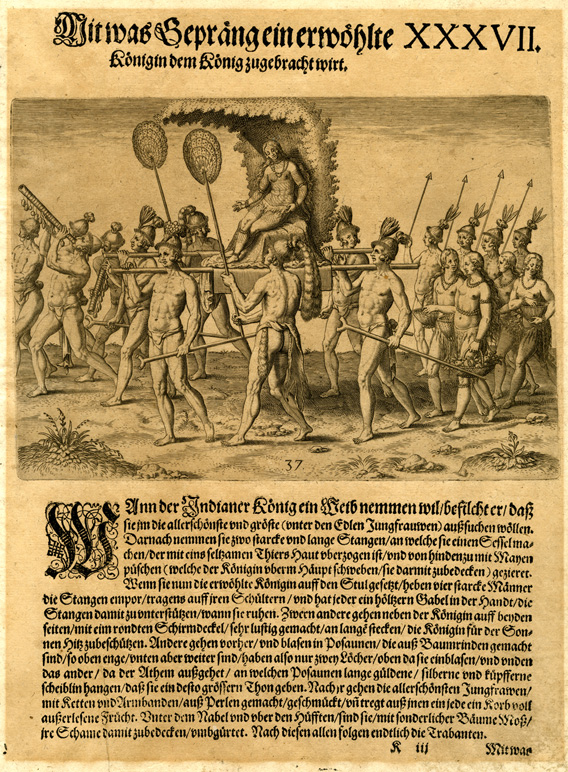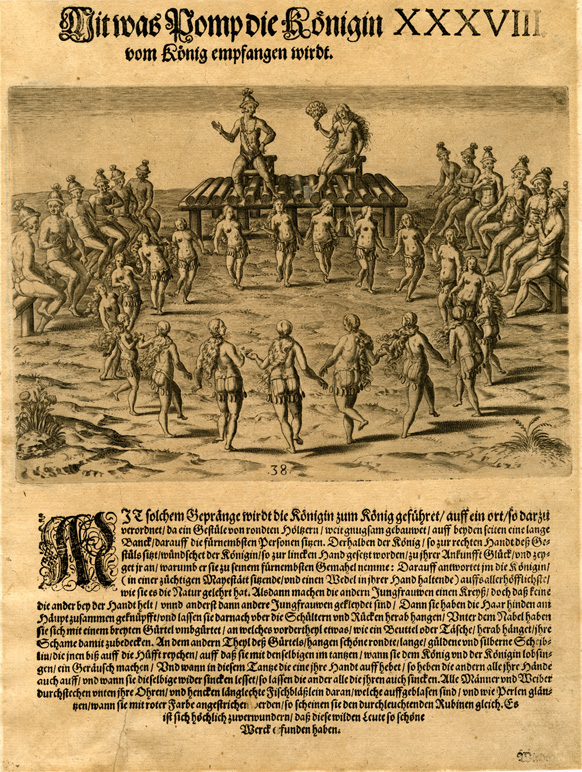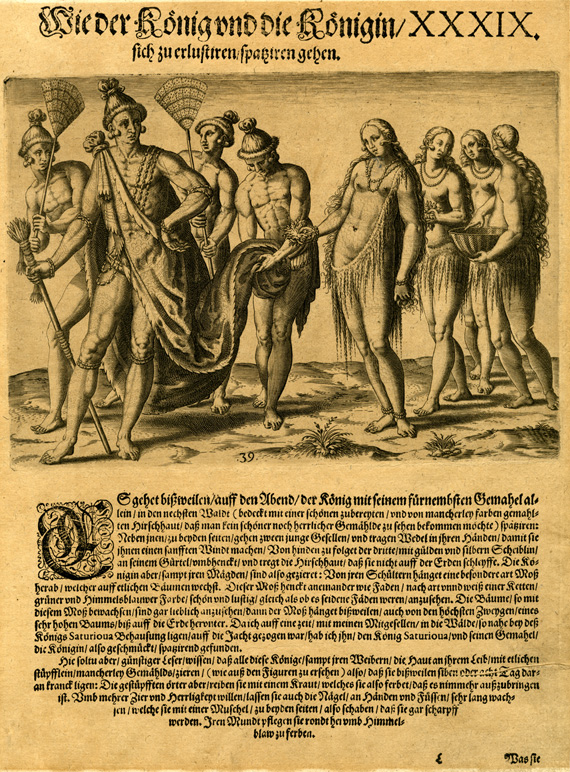I
The Promontory of Florida, at Which the French Touched; Named by Them the French Promontory
During their first voyage to Florida, the French landed near a well wooded headland, slightly raised from the surroundings flat coastline. In honour of France the commander of the fleet named this place which is about thirty degrees from the equator, the French cape. Coasting northward, they discovered a deep and beautiful river at whose mouth they cast anchor in order to examine it in more detail the nest day. On his second expedition Laudonnière called it the river of Dolphins because he had seen large numbers swimming there. When they disembarked they saw many Indians coming to give them a kind and friendly welcome, even making them presents of the skins they wore. After accepting many gifts from the commander of the expedition the Indians brought them to their king, who had not risen up, but remained seated on branches of laurels and palms. This king made our captain a present of a large animal skin decorated all over with very lifelike drawings of animals of the forest.
II
The French Sail to the River of May
Re-embarking, the French sailed on further. As they came in to land they were greeted by another tribe of Indians, some of whom waded in the water up to their shoulders offering up little baskets of maize full of red and white mulberries, while others offered to help them come ashore. Having landed, the Frenchmen saw the Indian chief, who was accompanied by his two sons and a company of his men armed with bows and quivers of arrows. After exchanging greetings our men proceeded into the forest hoping to discover many wonderful things. But they saw nothing except for some trees bearing red and white mulberries whose tops were covered with innumerable silk worms. The French named this river the May, because they sighted it on the first day of that month.
III
Leaving the River of May, the French Discover Two Other Rivers
They returned on board and having raised anchor navigated along the coast until they came to a beautiful river which the commander himself wished to explore with the chief of that vicinity and some of the natives. Captain Ribault named it the Seine because it was like the river in France. It is about fourteen leagues from the river of May. Having re-embarked they continued sailing towards the north, but not far away they discovered another river just as pretty and sent off two boats to explore it. In it they found an island whose chief was no less friendly than the others. They named this river the Aisne (Axona). It is about six miles from the Seine.
IIII
Six Other Rivers Discovered by the French
Sailing hence, about six miles further on they discovered another river which they called the Loire and subsequently five others, of which the first was named Charente, the second Garoone, the third Gironde, the fourth Belle, and the fifth Grande. After exploring them thoroughly they made many observations in an area of less than sixty miles, finding many singular things. However, not being content with that, they advanced further north, following the route which would lead them to the river Jordan, perhaps the most beautiful of all seven rivers.
V
The French Reach Port Royal
Resuming their route, the French found a river which they called Bellevue. Three or four miles further on they were told that there was another deep river not far away which surpassed all the others in size and beauty. When they reached it they found it so magnificent and great a stream that they called it Port Royal. Here they lowered the sail and dropped anchor at ten fathoms. The commander of the expedition and the soldiers that went ashore with him found it a very pleasant place, well wooded with oak, cedar and other types of tree. As they walked in the forest they saw turkeys flying and stags wandering. The mouth of this river is three miles wide and splits into two arms, one towards the west and the other to the north. This latter (according to the opinion of some) penetrates deep into the interior towards the river Jordan. The other, as has been observed, throws itself westwards into the sea. Midway between the two branches is an island whose point faces the mouth of the river. The French re-embarked and took the northern branch in order to see what advantages it might have. After about twelve miles, they saw a company of Indians who, at the sight of the boats, fled, leaving behind a wolf's whelp which they were in the middle of eating. For this reason they called the place Wolf's Point. Sailing further, they came across another branch of the river, which came from the east. The commander decided to leave the main stream and continue along this other arm.
VI
The French Commander Erects a Column with the Arms of the King of France
We returned on board and spent the night there. The captain of the expedition had the arms of the King of France engraved on a column and ordered it to be loaded on a small boat, ready to be erected in some pleasant and well chosen spot. The French sailed on three miles further where they noticed a small stream, and continued until they saw that this little creek joined the bigger one, thus forming a small island. They disembarked and finding it a pleasant place, the commander ordered the column to be placed on a bare mound. They saw two stags of a gigantic size, larger than any they seen before. They could easily have killed them with their arquebuses, but he captain, who was impressed by their extraordinary size, forbade it. Before re-embarking they gave the river that surrounded this little island the name of Libourne. They continued their explorations on another island, not far from the first. Here they discovered some very high cedars, taller than they had seen anywhere else in this region, so they called it the island of Cedars. They then returned aboard. The little island in which the column was erected is marked by a letter F in this engraving.
VII
The French Left in Fort Charles Suffer from Scarcity of Provisions
Not long after captain Ribault's departure from Florida, the French whom he left at Charlesfort began to suffer from lack of provisions. After considering how best to overcome this, they decided the best plan would be to turn for help to King Ovade and his brother Covexis. They delegated a certain number among themselves to go off in an Indian canoe. After travelling about ten miles they discovered a beautiful river of fresh water where they noticed numerous crocodiles, much larger than those of the Nile. The banks of this river were covered with lofty cypresses. After a short stop they continued further and found Chief Ovade who received them with great kindness. They explained their predicament to him and begged him not to abandon them in their need. Chief Ovade was friendly and understanding and sent to his brother, requesting beans and maize. Covexis responded promptly and Ovade's messengers, on their return next morning, carried the provisions to the boat. The French, grateful for the king's generosity, wished to take leave of him but he would not allow it and detained them with him that day, entertaining them kindly. The next day he showed them his fields and said that they would not want for grain while his crop lasted. After leaving the king the French retuned by the same way they had come.
VIII
The Natives of Florida Worship the Column Erected by the Commander on his First Voyage
During the second voyage in Florida under Laudonnière's command, that leader went ashore with twenty-five arquebusiers. He was greeted by the Indians who had gathered in crowds to see the new arrivals. Their king, Athore, who lived five or six miles inland from there, welcomed them with great kindness and presented Laudonnière with gifts. He then gave the French to understand that he wished to show them something remarkable and begged them to follow him. They agreed, but seeing how many natives surrounded them, proceeded with caution. He conducted them to the island where Ribaut had erected on a hillock the tone column engraved with the arms of the king of France. On approaching the French saw the Indians worshipping the stone as an idol. The chief, having saluted it with the respect that his subjects were used to accord him, kissed it and the other Indians did likewise. Afterwards the French were encouraged to do the same. Before the monument lay baskets filled with the country's fruit, vases full of perfumed oils, roots both edible and medicinal, and a bow and arrows. From top to bottom the stone was wreathed with flowers of all kinds and branches of the rarest trees. After watching the rituals of these wretched barbarians, the French rejoined their companions in looking for the most suitable place to build a small fort. The king, Athore, is a handsome man, wise, honourable and strong, more than half a foot taller than even the tallest of our men. His modest gravity lends majesty to his already noble bearing. He married his mother and had by her several children of both sexes whom he proudly introduced to us, striking his thigh as he did so. It might be added that after he married his mother his father, Satourioua, ceased to live with her.
IX
The French Select a Place for Building a Fort
Having explored the numerous rivers of this region, it was decided that it would be better to build on the river of May than on any other. It had, in fact, been noticed that millet and maize were more abundant there than elsewhere, and besides, gold and silver had been found there during the first voyage. The French went, therefore, to this river and while sailing upstream they arrived at a place, close to a mountain, which seemed to them, of all the places they had seen up till then, the most fitting for the establishment of a fort. The next day, at sunrise, they prayed to God and gave thanks for their fortunate arrival in this province and they all went to work with a will. The outline of a triangle was measured on the ground and everyone got to work; some dug the soil, some put up wood fences, and other made entrenchments. Each person had his tool, spade, saw, axe, bill-hook and hatchet for cutting the trees and raising the fort. They put so much zeal into this work that it was finished in a short time.
X
Picture of Fort Caroline
Erected in the shape of a triangle, the fort was afterwards named Caroline. The west side, facing the land, was closed by a small ditch and an entrenchment made of sods of earth nine feet high. The other side, facing the river, was surrounded by planks and brushwood. On the south front, like a citadel, a sort of granary was erected for provisions. For this construction branches and gravel were used except for the top part of the entrenchment which was made of sods of earth two or three feet high. In the middle of the fort lay a roomy courtyard, eighteen yards square and entirely level, which was the soldiers' place of assembly, their quarters being on the southern side. On the north side a construction was raised too high and in consequence soon collapsed in the wind. Thus, experience taught us that in this country, where winds are so furious, buildings must be made lower. There was also another quite spacious site, one of whose walls was contiguous to the granary, mentioned above, while opposite, overlooking the river, was Laudonnière's residence, surrounded on all sides by a gallery. The front door of this house opened onto the courtyard, the back door onto the river. To avoid fires, an oven was built at quite a distance from the fort because the houses, roofed with braches, would have caught fire very easily.
XI
Ceremonies Performed by Saturioua Before Going on an Expedition Against the Enemy
It is reported in the account of the second expedition, that the French made a treaty of alliance and friendship with the powerful king of the vicinity called Satourioua, in order to be able to erect a fort on his territory. It was agreed that their friends and their enemies must be the same, and in time of need they must lend each other support. Now, about three months after this treaty was made the king sent to Laudonnière for arquebusiers as he wanted to make war on a neighbour. Laudonnière despatched Captain Caillot with several soldiers to him, telling the captain to say that at the moment he could not supply him with men because he hoped he would be able to make a reconciliation with this enemy. Indignant with this reply, the king decided to leave immediately (he could not defer his expedition because he had collected all the necessary provisions and summoned the neighbouring kings). So, in the presence of the soldiers sent by Laudonnière, he assembled his men, all decked out in feathers and other ornaments of Indian fashion, and they sat down in a circle around him. A log fire was lit at his left, and at his right two big vases of water were placed. As if seized by a violent anger, the king, rolling his eyes terribly, began making a deep throaty sound and then, gesticulating wildly, let out some horrible cries which his soldiers repeated, striking their hips and rattling their weapons. Next, the king took a wooden bowl full of water and turning towards the sun worshipped it and asked it for victory over his enemies; that he might spill their blood as he was going to spill the water with which he had filled his bowl. With a quick movement he threw the water in the air and as it fell upon his soldiers he cried out "May you do with my enemies' blood the same as I have just done with this water." The water from the second bowl was thrown in the fire and the king cried out "May you thus extinguish my enemies and return with their scalps." Then they got up and set off on their expedition.
XII
Outina, going at the Head of His Army, Against the Enemy, Consults a Sorcerer on the Event
Laudonnière sent several Indian prisoners back to their king, Outina, who lived about forty miles south of the French fort. These men had been captured by Satourioua during the previous expedition. As a result of the French action a solemn treaty was concluded with Outina and reciprocal friendship promised. The reason for the French wanting this treaty was that this king's territory could offer access, both by land and by river, to the Appalachian mountains where gold, silver and copper was found. Having the friendship of this king which scarcely lasted a year), the French could easily reach these mountains. Under the terms of this alliance he asked Laudonnière for a few arquebusiers to help him make war on his enemy. He was sent twenty-five men under the command of Ottigny. He received them with great pleasure, counting on victory because of their co-operation, for the fame of their weapons had spread into the neighbouring countries and inspired terror. Now the king was ready and they departed. On the first day the going was easy, on the second more difficult, across swampy ground, covered with thorny scrub. The Indians carried the French on their shoulders which was a great relief to them in the strong heat. At last they arrived at the frontier. The king then halted his army and called an ancient magician who was more than a hundred years old, bidding him reveal the enemies' dispositions. The magician cleared a space in the middle of the army and on seeing Ottigny, he asked for the shield his page was brandishing. This he put on the ground and drawing a circle of five feet diameter around it, he inscribed some letters and signs in the circle. Kneeling with his heels on the shield, he sat in such a way that he was not touching the ground anywhere. Mumbling unintelligibly, he gesticulated as if he was engaged in a vehement discourse. After a quarter of an hour he looked so terrifying that his face no longer seemed human. He contorted himself until his bones could be heard cracking and he did many other things besides that were most unnatural. At last, exhausted and as if confused, he resumed his original aspect. Then he left the circle, saluted the king and informed him of the number of enemies and in which place they were awaiting him.
XIII
Outina, With the Help of the French, Gains a Victory over His Enemy Potanou
So frightened was the chief by the sorcerer's words, that he no longer thought of attacking, but rather of how he might return home safely. However, Ottigny, indignant at having gone to such trouble without results, told him he would take him for a lowborn man and not a king if he did not dare risk his luck. At length these threats and insults forced him to attack. With their consent, he put the French in the front line, and indeed it is certain that had they not sustained the whole brunt of the battle and massacred so many of the enemy, causing King Potanou's army to flee, Outina would have been beaten. The magician was surely inspired by a spirit, for all he predicted was correct. Outina, content with the flight of his enemy, recalled his men and ordered them to return home, much to the irritation of Ottigny, who would have preferred to follow up his victory.
XIIII
Order of March Observed by Outina on a Military Expedition
When King Satourioua left for war, his soldiers advanced in no particular order, scattered on all sides. On the other hand his enemy Olata Outina, of whom I have already spoken, and who is considered the king of kings, superior to all others in his number of subjects and his riches, marches with his troops in military formation. He goes alone in the middle of his ranks, painted red. The wings of the army, in the order of march, are composed of young men, the fittest of whom, also painted red, are used as runners and scouts to reconnoitre the enemy troops. Like dogs after wild beasts, they hunt the enemy by scent, and when they find traces of them they run back to their army to report. In the same way that our soldiers pass orders by trumpets and drums, they use heralds who have certain cries for when to halt, or to advance, or to attack or make some other manoeuvre. They stop at sunset and never fight at night. When they set up camp, they divide up into squads of ten, the bravest apart. The king chooses a place in the fields or in the forest to pass the night and after he has eaten and gone to rest the masters of the camp place ten squads of the bravest men in a circle around him. About ten yards away some twenty other squads form another circle around the first. Twenty yards further away there is another circle of forty and this formation continues enlarging according to the size of the army.
XV
How Outina's Men Treated the Slain of the Enemy
During all the time that the French had dealings with the great chief Olata Outina in the war against his enemies, no pitched battle was fought. It all happened in ambushes and skirmishes, fresh troops constantly replacing those who retired. Whoever put the enemy to flight first was credited with victory, even when the number of his losses was very large. In these skirmishes those who fall are immediately dragged off by men especially charged with this duty. With a sliver of reed, sharper than any steel blade, they cut the skin with the hair from the skull all the way round, the longest hairs being twisted into a plait, the hair from the forehead being rolled up for the length of two fingers with that of the back of the head in the manner of the ribbon of a bonnet. Immediately afterwards (if they have time), they dig a hole where they make a fire of smouldering moss which they carry around in their leather breechclouts. The fire lit, they dry the scalp until it becomes hard like parchment. At the end of the battle, they are accustomed to cut the arms of their victims off at the shoulder and their legs at the thighs. The bones laid bare are crushed and the pieces, still dripping with blood, are dried on the same fire. Then they return home triumphantly with the skin of the heads at the ends of their spears. What astonished me (for I was one of the men sent by Laudonnière under Ottigny's command), was that they never left the place of battle without piercing the mutilate corpses of their enemies right through the anus with an arrow. During this task a protective force always surrounded them.
XVI
Trophies and Ceremonies after a Victory
On their return home from a military expedition they reunite in a place selected for that purpose. There they pile up the arms and legs and scalps of their enemies with solemn ceremony on rows of tall poles set in the ground. The men and women sit in a circle around the sorcerer who, clutching a small image, mutters a thousand imprecations, cursing the enemy. Over on the far side three men are kneeling. One of them, holding a club in both hands, strikes a flat stone, as if in time to the words of the sorcerer. On his left and on his right two other men are seated. They hold in their hands the fruit of a certain plant which grows like a gourd or melon. This fruit has been pierced at both ends, hollowed out and dried. The Indians fill this container with small stones or seeds; they attach a stick handle and shake it to make a noise like hand-bells. All this is accompanied by chanting in the national manner. These ceremonies are celebrated each time they take prisoners.
XVII
Employments of the Hermaphrodites
In this country there are numerous hermaphrodites, a mixture of both sexes. They are considered odious by the Indians, but as they are robust and strong they are used to carry loads instead of beasts of burden. When the kings set out to war, it is the hermaphrodites who transport the supplies. They place the Indians, dead from either wounds or sickness, on a stretcher made of two stout poles covered with a mat of woven thin canes. The head rests on a fur; a second fur is wound around the stomach; a third around the hips; a fourth is placed around the calves. (I did not ask the reason for this custom, but I suppose it is for show, for sometimes they do not do all this and simply bind one leg.) Next they take belts of leather, about three or four fingers wide and fix them at both ends of the poles and put them on their heads, which are very hard; then they carry their dead to the place of burial. Persons with infectious diseases are carried to places reserved for them on the shoulders of the hermaphrodites who supply them with food until they are well again.
XVIII
The Chief Applied to by Women Whose Husbands Have Died in the War or by Disease
The women whose husbands have succumbed in battle or have died from illness have the custom of assembling on a day that seems to them most suitable to appear before their king. They approach him, overcome with grief, sit down on their heels, and covering their faces with their hands, they cry out and moan. They ask the king to avenge their dead husbands, to provide them with means to live during their widowhood and to permit them to remarry after the time laid down by law. The king, taking pity on them, grants their requests. They return home, weeping and wailing, as proof of the love they felt for their husbands. After having spent several days in mourning they carry their husbands' weapons and drinking cups to their tombs, then they start to weep again and celebrate other funereal ceremonies.
XIX
Ceremonies of Women Mourning for their Deceased Husbands
After arriving at their husbands' burial place, in memory of these brave men they cut their hair below their ears and scatter it on the graves where they have already thrown their husbands' shell drinking-cups and weapons. Then they return home, but are forbidden to remarry until their hair has regrown long enough to cover their shoulders. They also let their toe and finger nails grow, filing the sides to make them pointed. But it is above all the men who practice this custom. Whenever they can grab hold of an enemy, they sink their nails deep into his forehead and tear the skin, leaving him blinded and bloody.
XX
Mode of Treating the Sick
As can be seen from this engraving, the Indians make a long wide platform where they lay the sick person, with his face up or down according to his complaint. With the help of a pointed instrument, a hole is made in the forehead from where blood is sucked through the mouth and spat into an earthen vessel or gourd bottle. Women who are suckling boys or who are with child or suffering from some disease come and drink this blood, especially when it is that of a strong young man, so that it may improve their milk and make their offspring stronger and more energetic. To others, lying face down, they administer fumigations by throwing certain seeds on the fire. The smoke, entering by the mouth and nose, circulates the entire body and induces vomiting and so expels the cause of the sickness. The Indians possess a certain plant whose name is petum in Brazil and which the Spanish call tapaco. The dried leaves of this plant are put in the widest part of a pipe. The Indians set it on fire and inhale the smoke so deeply from the narrowest part of the pipe that it comes out through the mouth and nose at the same time dispelling the humors. They are also extremely subject to venereal diseases, to cure which they have special remedies provided by nature.
XXI
Mode of Tilling and Planting
The Indians cultivate the earth with diligence. They have learnt to make hoes with fish bones and to fit them with wooden handles. With these they can dig the soil quite easily as it is not heavy. Once the earth has been well broken up and leveled, the women sow beans or millet or maize. To do this they are helped by people who precede them with a stick, and make holes in the soil where the grain or bean or millet is thrown. The sowing completed, they leave the field alone. It is, in fact, then their winter season which is quite cold in this region and which lasts three months, from 24 December to 15 March. Being always naked, the Indians then seek shelter in the forests. The winter over, they return to their houses, anticipating the ripening of the crops. The harvest gathered, they store the corn for the year's uses, and do not trade with any of it except perhaps for some exchange of household articles.
XXII
Industry of the Floridians in Depositing Their Crops in the Public Granary
There are in this country many islands that produce an abundance of various fruits which they harvest twice a year. These fruits the Indians take home in boats. Then they stack them up in storehouses which are simple yet large and built of mud and small stones. They are roofed with thick branches and soft earth, suitable for this purpose. Usually, these storehouses are built under a hill or rock close to a river. In order to prevent the fruit from rotting, the sun's rays must not penetrate the building. Apart from the fruit, the Indians put there other food that they wish to keep. They go and take it whenever they need it without any disagreement among themselves. It could be wished that such a lack of avarice prevailed among Christians and then their minds would be less tormented.
XXIII
Bringing in Wild Animals and Other Stores
At a certain time of year the Indians collect all kinds of game, fish and even crocodiles. Baskets are filled with these creatures and put on the shoulders of curly-haired hermaphrodites whom we have already described. All this is taken to storehouses where it is not touched except in cases of extreme need, when, to avoid disputes, the Indians come to an agreement among themselves, which illustrates the harmony that exists among them. However, the king is at liberty to take what he chooses.
XXIIII
Mode of Drying Fish, Wild Animals, and other Provisions
In order to preserve the flesh of animals, they prepare them in the following way: four strong forked stakes are planted in the ground over which are laid more sticks, forming a grating to take the animals and fish. A fire is lit underneath in such a way that the meat may be dried by the smoke. As the picture shows, the Indians take great care with this procedure so that provisions do not spoil. I suppose that they prepare all this for the winter months when they are in the forests since at this time we were never able to obtain anything from them. As we have said before, the storehouse is on a rock or some shelter, near a river and not far from a big forest so that they can take provisions there in canoes whenever necessary.
XXV
Hunting Deer
Nowhere have we seen stag hunting as the Indians do it. They put themselves inside the skins of the largest stags they have been able to kill, so that their heads are in those of the animals. As with a mask they see out through the holes of the eyes. Thus dressed they can approach the deer closely without frightening them. Beforehand they find out the time when the animals come to the river to drink. Bow and arrow to hand, it is easy for them to aim, especially since stags are numerous in this country. Experience has taught them to protect their left arm with a piece of bark to avoid being hurt by the string of the bow. They know how to prepare the skins in a wonderful way, without iron instruments, using shells. In my opinion, no one in Europe could rival their skill.
XXVI
Killing Crocodiles
The Indians' method of killing crocodiles is as follows: on the edge of a river they erect a small hut, full of holes and slits, where a watchman is stationed so that he is able to see and hear the crocodiles from afar. These creatures, driven by hunger, climb up out of the rivers and crawl about on the islands in search of prey. When they find none they make such a ghastly noise that it can be heard half a mile away. At this moment the watchman calls the hunters who are in readiness. Grasping a pointed tree trunk ten or twelve feet long, they advance towards the animal, who usually crawls along with open mouth, and when he opens his mouth they quickly plunge the thinnest part of the pole into it in such a way that he cannot get it out because of the roughness and irregularity of the bark. Turning the crocodile over, they then pound and pierce his belly, which is the softest part of his body, with blows from clubs and arrows. The backs of these animals, particularly those of the old ones, are impenetrable, covered as they are with hard scales. Such is the Indians' method of hunting crocodile. These animals trouble them so much that they have to keep a watch against them at night and sometimes even in the day, as if they were guarding against some dreadful enemy.
XXVII
Floridians Crossing Over to an Island to take their Pleasure
As can be seen from the preceding illustrations, this area abounds with very agreeable little islands. The rivers are not deep; the pure, clear water scarcely reaches the chest. When the Indians want to make an enjoyable excursion with their wives and children, they go to these islands. They either swim across the river (for they are excellent swimmers) or they wade across carrying the little children. In fact the mothers can manage three children at once, the smallest on a shoulder clutching its hand, and the other two under her arms. With the free hand, the women carry a basket full of fruit or other food for the occasion. For fear of meeting enemies the men carry bows and arrows. In order not to wet them, they attach the quiver to their hair and hold the bows stretched and ready with and arrow, prepared instantly to defend themselves, as can be seen in our engraving.
XXVIII
Preparations for a Feast
At a certain time of the year, the Indians are accustomed to celebrate feasts among themselves, and for this purpose they have specially chosen cooks. They begin by putting a large, round, clay pot (so well made that water can boil in it just as well as in our vessels) on some logs which they light, while one of them holds a fan to encourage the flames. The chief cook throws what has to be cooked into the great pot; others pour water which has been brought to them in a vessel shaped like a bucket into a hole for washing; another uses a flat stone to crush the herbs to season the food; and meanwhile women are busy sorting out what is necessary for the cooking. In spite of these great feasts the Indians are very moderate in their eating, thanks to which they live to a great age. One of their chiefs asserted to me that he was three hundred years old and that his father, whom he pointed out to me, was fifty years older than he. It is true to say that on looking at him, he seemed all skin and bones. The Indians put us Christians to shame, for we, by over-indulgence in food and drink, shorten our lives considerably. We should attend the Barbarian school in order to learn temperance.
XXIX
Proceedings of the Floridians in Deliberating on Important Affairs
On certain days of the year the king usually assembles with his nobles in a place specially prepared for this. There, there is a large bench constructed in a semi-circle with a projection made of nine tree trunks in the centre, which serves as the throne of the king. He sits here, all alone, so he can look distinguished and the others come, in turn, to salute him. First the oldest make their obeisances, by twice raising their hands to their head and saying 'Ha, he, ya, ha, he' to which the others reply 'ha,ha.' After saluting the king, everyone goes and sits down on the bench. If any question of importance is to be discussed, the chief calls first upon the jawas (that is, the priests) and upon the elders to each give their opinion. The Indians, in fact, never make any decisions without first having listened to all the various opinions and discussed them. Then the king orders the women to prepare some casina which is a beverage made from the leaves of a certain plant passed through a strainer. Then, an Indian, stretching out his arms, says some prayers to the king and those who are going to partake of this hot drink, which is then passed round in a big shell, first to the king and afterwards, in strict order of protocol, to the others. This drink is so highly esteemed, that no one is allowed to drink it in council unless he has proved his courage in battle. Moreover it causes sweating almost immediately after it has been swallowed. Also those who cannot keep it down and throw it up are never confided with any difficult task or military responsibility, being considered useless; for on campaigns the Indians often have to go three or four days without food, but having once managed to drink this liquor, it is possible to go twenty-four hours afterwards without food or drink. When setting out on an expedition, the hermaphrodites carry nothing but this drink, contained in gourds or wooden receptacles. This is because casina nourishes and fortifies the body without causing drunkenness, as we have observed on occasions.
XXX
Construction of Fortified Towns among the Floridians
This is how the Indians construct their towns: they choose a place near a swift stream and level it as much as possible. Next they make a circular ditch and fix in the ground, very close together, thick round palings the height of two men. At the town's entrance they make the opening of the circle narrower, in the form of a spiral so that this entrance does not admit more than two men abreast at a time. The course of the stream is diverted to this point. At the beginning and end of this passage a round edifice is erected, full of holes and slits which, considering their means, are constructed very elegantly. In each, sentinels who are expert at smelling the enemy from afar are stationed. As soon as they detect the scent of the enemy, they rush out, shrieking, to find him. At this alarm the inhabitants of the town run out to defend their fortress, armed with bows and arrows and clubs. The king's dwelling is in the middle, and has been a little sunk into the ground to avoid the sun's heat. All around it are grouped the nobles' houses, lightly constructed and roofed with palm branches. As has been mentioned earlier, they only spend nine months of the year here, emigrating to the forest for the rest of the time. They make new houses with the same materials, if, on their return, they find they have been burnt down by the enemy. Thus magnificent are the palaces of the Indians.
XXXI
How They Set on Fire and Enemy's Town
Burning with revenge, the enemy will sometimes creep up at night, as silently as possible, to see if the sentinels are asleep. If they hear nothing, they approach the town. The points of their arrows are already trimmed with dry moss which they set alight and then shoot the arrows at the roofs of the houses which are made of branches, dried out by the heat of summer. When they see the roofs in flames, they quickly withdraw, before the inhabitants have noticed anything. They run so fast that it is difficult to catch them. In any case the people in the town have enough to do trying to extinguish the fire and make it easy for the incendiaries to escape. Such is the strategy used by the Indians to destroy a town of an enemy. The loss is not very great, though, because the construction of new houses merely requires some extra work.
XXXII
How Sentinels are Punished for Sleeping on Their Posts
When a town is burnt due to the negligence of the sentinels, they are punished in the following manner: the chief is seated alone on his chair with the most senior Indians sitting on a semi-circular bench and the executioner forces the guilty men to kneel down before them. Taking a club of ebony or some other hard wood filed to an edge on both sides, he puts his left foot on their backs and strikes them such a blow with both hands on the club that he almost splits their skulls in two. This same penalty is meted out to any who are accused of what is considered to be a capital offence. We were, in fact, present at two such executions.
XXXIII
How They Declare War
When a king wishes to declare war on his enemy, he does not send heralds to announce his intentions. He orders arrows with locks of hair attached to the notches to be stuck along the public ways. We observed this practice when we conducted King Outina, as a prisoner, through villages that he governed, to make them supply us with provisions. These arrows were later carried back to the fort by Ottigny.
XXXIIII
First-Born Children Sacrificed to the Chief with Solemn Ceremonies
The Indian custom is to offer as a sacrifice to their chief, their first-born son. On the appointed day the chief goes to a place specially assigned for the purpose and there sites down on a bench. In the middle of the area there is a tree trunk which is two feet high. The mother of the child squats in front of this, her face covered by her hands, lamenting the death of her first-born. The most distinguished of her relations or friends offers the child respectfully to the king. The women who have accompanied the mother sit in a circle, then they get up and dance and sing joyously, without joining hands. The one who holds the baby goes into the middle of the dancing women, also dancing and singing praises. On another side of the place six specially chosen Indians are standing round the sacrificer, who is magnificently decorated and solemnly holds a club. When the ceremonies are over, he seizes the child and, in honour of the chief, slays it on the wooden stump, in the presence of the assembled company. We saw this sacrifice carried out.
XXXV
Solemnities at Consecrating the Skin of a Stag to the Sun
Every year, a little before spring, that is to say at the end of February, King Outina's subjects take the skin of the largest stag they have been able to capture. Leaving on its antlers, they stuff this skin full of the most delicate plants which grow there and sew it up. At the antlers, the neck and the stomach they hang the best of their fruit, made into wreaths or garlands. Thus decorated, this effigy is carried to the sound of flutes and harmonious songs, to a special place, large and level. Here it is put on a high tree with its head and breast facing the rising sun. Then the Indians say prayers to the sun so that it will give them again good fruit similar to the ones offered to it. The king and his sorcerer stand near the tree singing chants to which the people, standing apart, make the responses. Then the king and all his retinue salute the sun and depart, leaving the deer's hide where it is until the following year. They repeat this ceremony annually.
XXXVI
The Youth at Their Exercises
They young are trained at running. He who runs the longest without stopping receives a prize chosen by the competitors themselves. They also frequently practise with the bow. They have a ball game they plays as follows: in the middle of an open space they set up a tree trunk eight or nine fathoms high, and at the top they fix a sort of hurdle. He who manages to hit it is declared the winner. They also enjoy hunting and fishing.
XXXVII
The Display with Which a Queen Elect is Brought to the King
When the king wishes to get married, he orders the most beautiful and the tallest girl from among the most noble families to be chosen. Then a seat is fixed on two stout poles and covered with the skin of some rare animals. Behind the seat a structure of branches is made so as to shade the head of the sitter. The queen-elect is put on this chair and four strong men take up the poles and carry them on their shoulders. They each carry a wooden fork on which to put the poles when they halt. On each side of the queen walk two men waving elegant fans, attached to long handles, to protect her from the ardors of the sun. Other men go before, blowing trumpets made of tree bark. These instruments have only two holes, one at the top and one at the bottom; they are narrower at the mouth end than at the other end. Hanging from them are oval balls of gold, silver and copper which are designed to make a very harmonious sound as they knock against each other. Then follow the most beautiful of the young girls, all decked out with necklaces and bracelets of pearls. Each carries a basket full of the choicest fruit. For the sake of decency they hang moss from their naval to their thighs. After them come the bodyguards.
XXXVIII
Solemnities at the Reception of the Queen by the King
It is with great pomp that the queen is led to the king in a place specially designed for that purpose. There a large platform made of logs has been erected, and on each side of it are benches for the nobles. Seated on the right, the king welcomes the queen who takes her place on his left, and he tells her the reasons he has chosen her to be his wife. The queen, a fan in her hand and full of majestic reserve, answers the king as graciously as her education has taught her. Next the young girls, now wearing a different costume, form a circle without touching each other. Their hair floats over their shoulders and down their backs, a wide belt encircles their hips and a sort of purse hides their intimate parts; pendants of gold and silver are attached to their belts and tinkle when the girls dance and sing the praises of the king and queen. When one of them raises her hand the others copy her, they do likewise if she lowers it. Men and women have the ends of their ears pierced in which they put little inflated fish bladders, bright as pearls, painted red and looking like carbuncles. It is astonishing that such savage people should have created such tasteful devices.
XXXIX
The King and Queen taking a Walk for their Amusement
Sometimes, in the evening the kings goes for a walk in the neighbouring forest with his first wife. He wears a stag skin, most elegantly prepared and painted in incomparable colours. At his sides two youths wave fans to make a breeze for him; a third, his belt ornamented with little gold and silver balls, holds the king's robes up to prevent them touching the ground. The queen and her handmaidens wear a kind of moss that grows on trees falling from their shoulders. This moss is interlaced into delicate tresses which make chains of an azur blue; they are so pretty that one would say they were filaments of silk. The trees that have this moss look very beautiful for it often falls from their tops right down to the ground. We have often seen it while on hunting expeditions with our companions in the forests near where Satourioua lives and I saw him and his Queen thus decorated. All these chiefs and their wives have their bodies pricked with certain pictures which sometimes make them ill for seven or eight days. They rub the pricked places with a special herb whose sap gives an indelible stain. They believe they embellish themselves by letting their finger and toe nails grow and by filing them with a shell into sharp points. They also outline their mouths in azur blue paint.
XL
Ceremonies at the Death of a Chief or of Priests
When a chief from that country dies, he is buried with great solemnity. The cup from which he used to drink is placed on his tomb which is surrounded by arrows stuck in the ground. His subjects mourn him for three days and three nights without eating or drinking. All his friends do the same, and in testimony of the affection they held for the deceased, both men and women cut off more than half their hair. During the next six moons, women specially chosen for the task lament the death of their king at dawn, midday and twilight with great howls. All the king's personal property is carried to his house where it is burnt. They do the same thing for priests.
XLI
Mode of Collecting Gold in Streams Running From the Apalatcy Mountains
Some considerable distance from the place where we have constructed our fort, rise some high mountains called Apalatcy in the Indian tongue. As can be seen from our map, these mountains give birth to three rivers in whose sand there is much gold, silver and copper. The natives dig trenches near the banks of the rivers so as to catch the sand brought down by the current. The water rapidly fills these up and goes on further. A short time later the Indians remove the sand which has gathered there with hollow reeds and convey it by canoe down the great river which runs into the sea and which we named the river of May. The Spaniards have taken great advantages of the riches coming from these places.
XLII
Murder of Pierre Gambre, a Frenchman
We have spoken in our account of a certain Pierre Gambie, a delegate of Laudonnière. In carrying his merchandise across the country to sell it, he had traded so honestly that not only had he enriched himself but he had also married into the family of one of the kings of the region. The king allowed him to leave to pay us a visit on condition that he returned after a certain number of moons. He gave him a canoe and two Indians to accompany him. Thus he embarked with his riches, but his traveling companions slew him while he was poking a fire. They had two motives for this: the first was revenge (Gambie, who during the king's absence was managing his affairs, had killed one of their tribe with a stick); and the second was greed. Having seized the riches stored in the boat, they fled and the deed remained unknown for some time. This picture has been put in at the end so as not to disturb the order of the preceding series. We would not have reproduced it had not the author of the narrative recalled the event.
The digital copies of the de Bry engravings (N2012-6) included here are made possible by a donation from the Michael W. and Dr. Linda Fisher Collection.
All translations are taken from Discovering the New World, Based on the Works of Theodore de Bry, edited by Michael Alexander (New York: Harper & Row, 1976).

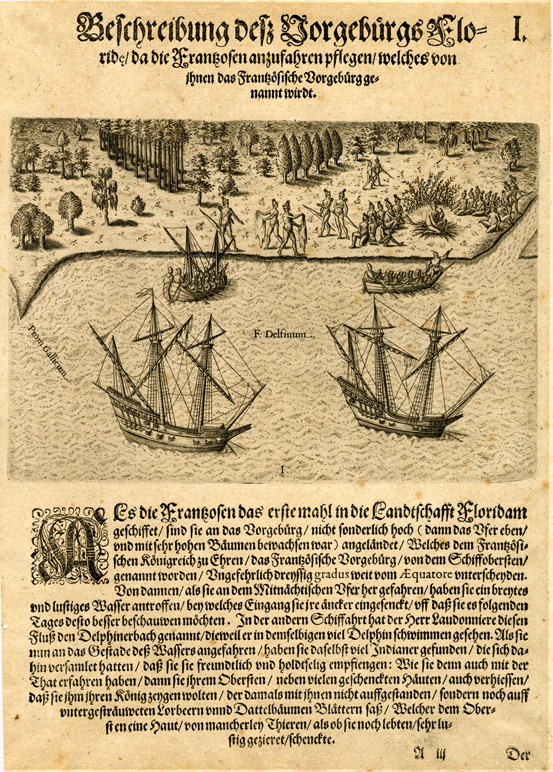


 Listen: The Folk Program
Listen: The Folk Program